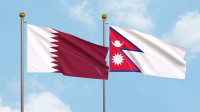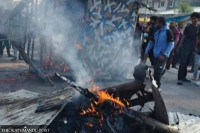National
Nepal witnessed economic recession but quick recovery likely, economists say
There was negative growth in the last quarter of 2019-20 and first quarter of 2020-21. In the final analysis year-on-year growth in the last fiscal year was -1.99 percent.
Sangam Prasain
Nepal’s economy faced headwinds, technically recording an economic recession for the first time in almost 40 years with the country witnessing negative growth rates for two consecutive quarters because of the Covid-19 pandemic-induced supply and demand shock on the economy.
According to the Central Bureau of Statistics, in the fourth quarter of the last fiscal year 2019-20, ending mid-July, the country’s economic growth rate, or output of the gross domestic product, plunged 15.4 percent compared to the same period in 2018-19, which resulted in a year-on-year negative growth rate of 1.99 percent.
This is the first annual negative growth rate since 1982-1983 when Nepal’s economic growth rate plunged to -2.97 percent, according to the World Bank.
The Central Bureau of Statistics had then attributed the negative growth rate to a drought in 1980-81 that led to a severe food crisis.
The negative growth rate continued in the first quarter of the current fiscal year 2020-21.
According to the Central Bureau of Statistics, in 2015-16 following the 7.8 magnitude earthquake in April 2015 that killed nearly 9,000 people, Nepal’s economy had recorded zero percent growth.
Since then Nepal recorded three consecutive years of substantial economic expansion, with growth averaging 7.3 percent per year.
The latest National Accounts Statistics that the Central Bureau of Statistics released on Thursday shows that the economic growth rate contracted by -4.6 percent in the first quarter of the current fiscal year 2020-21 compared to the same period in 2019-20, owing to localised restrictions even though the lockdown imposed on March 24 was lifted on July 21 last year.
“Technically, it’s a recession. When the growth contracts from one quarter to another, the economy is said to be in a recessionary phase,” said economist Shankar Sharma, former vice-chairman of National Planning Commission. “The country’s economic activities contracted for six months or more triggered by a particular event—Covid-19 pandemic—which severely impacted the income, employment and industrial production.”
Although there is no universally accepted definition of a recession—how long should the economy contract for it to be labelled as being in recession—the largely accepted working definition of a recession is two consecutive quarters of negative economic growth.
Most economists agree with the definition that the National Bureau of Economic Research of the United States uses, which says “during a recession, a significant decline in economic activity spreads across the economy and can last from a few months to more than a year.”
But economist Biswo Poudel does not agree that the data unveiled on Thursday necessarily reflects a cycle of recessionary growth as economic activities which were affected largely due to the Covid-19 pandemic are in a recovery phase in the current fiscal year.
“Economic activities are gradually picking up as many industries are now back to normal,” said Poudel.

Authorities share this view.
Hem Raj Regmi, deputy director general of the Central Bureau of Statistics, said that the country’s economy is making a V-shaped recovery–a quick and sustained recovery after a sharp economic decline.
Sharma, however, is keeping his fingers crossed. According to him, if the second quarter of 2020-21 sees the economy growing again, technically the recession will be over.
“Except for tourism and small and medium enterprises, other areas like transportation, restaurants and big industries are almost back on track,” said Sharma. “Most surprising is that remittances have not dropped and this has revived the demand for consumption resulting in big manufacturers to produce.”
However, the World Bank has warned Nepal could face negative growth this fiscal year too.
Even though the World Bank has forecast Nepal’s economy to grow at 0.6 percent in the current fiscal year, based on the global economic uncertainty associated with the Covid-19 pandemic—delay in a rebound in economic activity in the country’s major trading partners and remittance-sending countries—growth in 2020-21 risks turning negative.
Pushpa Kandel, the vice-chairman of National Planning Commission, during the unveiling of the data on Thursday said the government had forecast the 2019-20 economy to grow at 8.5 percent.
“But Covid-19 came and affected all sectors. Based on the prediction that the lockdown would be lifted in May and all economic activities would resume by June, in April we had forecast that the economy would grow by 2.27 percent,” he said. “But the lockdown prolonged causing a severe distress to the economy.”
The global crisis induced by the pandemic initially impacted Nepal through the tourism sector, with arrivals from China alone dropping by around 70 percent in February last year and a complete stop to the issuance of visitor visas from March meant tourist arrivals subsequently fell to zero.
Gradually, the impact of the pandemic spread to other sectors of the economy with the government imposing a nationwide lockdown which affected the industrial, trade, service and agricultural sectors. The four-month long lockdown led to massive job cuts.

“But still, with our agriculture or rural based economy, Nepal did not suffer to that scale in which other countries suffered,” said Kandel.
Before the pandemic, the planning commission had predicted a 9 percent economic growth this fiscal year, while the annual budget, despite the Covid-19, had set an ambitious target of 7 percent.
“Now, we have to review all our plans and policy as per the growth rate,” said Kandel.
Priority will be accorded to industrial growth and that will be based on agriculture production, Kandel said.
Meanwhile, Nepal has re-based its national account statistics, the announcement of which was also made on Thursday.
Rebasing of gross domestic product means replacing the earlier base year used for compiling the gross domestic product with a new, more recent base year for computing the constant price estimates.
As relative prices and the structure of the economy change over time, it is necessary to update the base year frequently. Nepal’s gross domestic product estimates are now rebased on 2010-11 from the earlier 2000-01.
Regmi, the deputy director general of the Central Bureau of Statistics, said that rebasing provides an opportunity to add new or more comprehensive data, incorporate new or better statistical methods, and apply advancements in classification and compilation standards.
The first gross domestic product series to be compiled for Nepal under international guidelines for national accounts compilation was based on 1964-65 prices.
With the new base year, the size of the Nepal economy increased by 14.1 percent in the base year 2010-11 to Rs1.55 trillion. Nepal’s economy or gross domestic product for 2019-20 is worth Rs3.94 trillion, which has grown 5 percent after rebasing the national accounts, said Regmi.
After the rebasing, Nepal’s per capita gross domestic product for 2019-20 is $1,134, up from $1,085 and per capita gross national income $1,148, up from $1,097.
In spite of the rebasing, the fact remains that the economy is not yet out of the doldrums.
“We suffered heavy economic losses in the last fiscal year and it may continue in this fiscal year as well,” said Kandel. “We have to backload these losses and compensate for it in the upcoming fiscal years [with a higher growth trajectory].”




 8.12°C Kathmandu
8.12°C Kathmandu













%20(1).jpg&w=300&height=200)

